
Geffrey đe Wulf of Half-farthing Head of the Wulfing Household


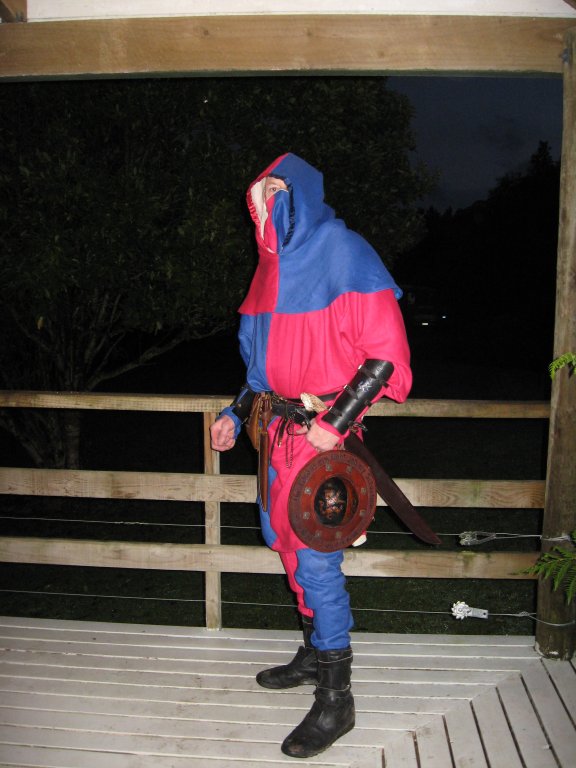
Born in 1313 at Battersea in the Brixton Hundred, County of Surrey. Originally destined to be a brewer, Geffrey stood as his father’s replacement archer at the Hundred Array from the age of 15. He was recruited by his distant relative, Sir Allan de Buxhall of Salehurst, Sussex, to serve as a Yeoman archer in the French wars of King Edward III. His service was good enough to become one of Sir Alan’s Household Archers. Since Sir Alan became Constable of The Tower of London, Geffrey has been based at The Tower. Rather than standard garrison duty, Sir Alan tends to use his distant cousin for “special duties”, many of which Sir Alan does not want to officially recognise. To meet the need for discretion, Geffrey has a large selection of livery outfits, few of which he is entitled to actually wear.
With money earned during the French wars Geffrey bought the tenancy of Halfarthing Manor in 1345, and later a three-generation lease on land at Garratt, which abuts Halfarthing.
Geffrey is married to Lucy á Becket. Geffrey’s service with Sir Alan means his wife and their eldest son, John, manage the farm.
Geffrey also made enough money to buy four houses in the city of London and a stables in Westminster. The stables are run by the wives and children of his two younger sons, Matthew and Thomas, who spend most of their time as archers in various English garrisons in Normandy and Gascony.
The connection of the Buxhall family with the house of Lancaster is providential for Geffrey, as the tacit support of the Duke of Lancaster for John Wyclif, and thus for the Lollards, whose beliefs the Wulf family subscribe to, mean that Geffrey and his family are able to avoid too close a scrutiny by the established Church authorities.
Robert the Miller of Waddon
in the Wallington Hundred, Surrey (also know as Dobb Wulf)Son of John and Mary Wulf, brewers of Battersea
Robert is the younger brother of Geffrey đe Wulf.
Born 1319, Battersea, Brixton Hundred, Surrey
Died 1402, Carleshalton, Wallington Hundred, Surrey
Married 1344, Widower: late wife Gwyn of Tenby Wales. They met whilst Robert was doing garrison duty.
Robert operates the water mill at Waddon under lease from Barking Abbey. He also has a small holding at Wallington, where the family live. The Archbishop of Canterbury has a Palace at nearby Croydon and owns much of the local land. He is keen to add Waddon to those holdings and thus put Robert & his family under his lordship. The family affinity (via Sir Allan de Buxhall) to the House of Lancaster prevents the Archbishop from inquiring too closely into the Lollard beliefs of Robert and his family.
Robert and his sons and daughter use the mill and the subsequent trade as a means to keeping touch with others of their belief in the Wandle Valley and also London.
Robert has served as a yeoman archer in France but his son now goes in his stead as and when called to do so.
Family:
Son
Robert Millers
Born 1346
Named for his father.
Robert works at the mill and on the small holding at Wallington. When an array is called Robert stands for his father as a yeoman archer.
During the reign of Edward III he went to France, serving in the company captained by his distant relative, Sir Allan de Buxhall, KG.
Son
Gareth Robertson (a Wulfing)
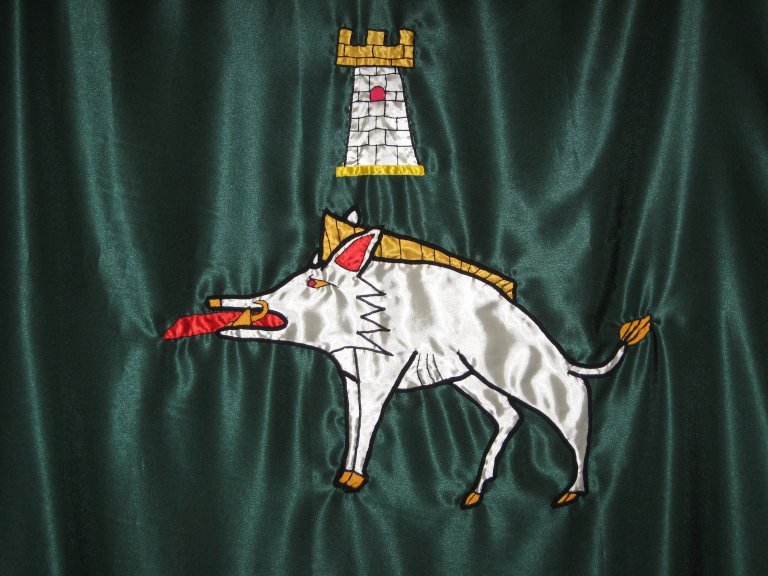

Awarded the honour of "King's Archer" Taupo Joust 2008 by the organisers. Gareth has served as King's Bodyguard and bodyguard to Baron Simpkin when he is in London. Fastest shoot 12 arrows in 35 seconds (Glenview School demo 2010).
Born 1351 Named for his mother’s brother who died at the Battle of Crecy. Helps out at the mill and works the small holding. He also helps his uncle, Geffrey
Well versed in scripture, Gareth is regarded as something of a hedge priest. The youth is keen to improve his archery and fighting skills in order that he may become a household archer.
Daughter
Guinivieve Louise Roberts
(called Gwyn by her uncle, Geffrey đe Wulf)(a Wulfing)
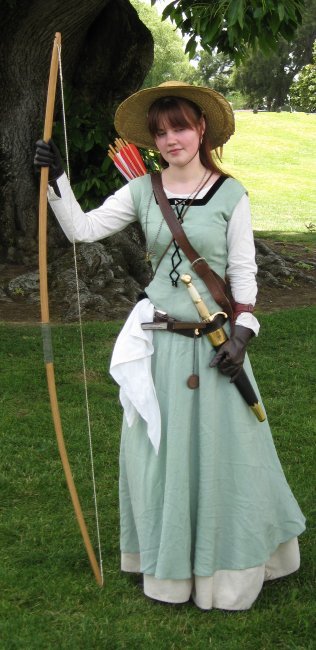
Born 1353
Named for herself (her father brought her first name from France, where he had been serving as an archer) and her grandmother.
Keeps house, runs the small holding and keeps the books for the mill.
Guinivieve often travels with Gareth to Half-farthing. At harvest and hay making she works in the fields there, but mostly she accompanies her Aunt Lucy taking produce to the London markets where, in addition to selling produce and delivering barley, they meet with fellow Lollards and obtain religious tracts to be distributed in Wandsworth and along the Wandle Valley.
(Gareth & Gwyn, together with Geffrey
đ Wulf are part of the SCA Household know as The WulfingsOther members of The Wulfings
Lachlan MacLachlan
, Master of Lachlan, son of Lachland MacLachlan, Laird of Lachland, from Lachlan in Scotland(a Wulfing)
Born? Possibly 1353, but the Scots are illiterate and thus have no written records.
Taken prisoner by the English when he took part in a border cattle raid, Lachlan was given to Geffrey
đ Wulf as a potential ransom payer in lieu of wages by John of Gaunt, Duke of Lancaster.The Laird of Lachlan , despite many requests, has so far failed to paid the ransom and the only supplies sent for the keep of Lachlan has been a barrel of cold porridge soon after his capture. In view of this, and in order to get some return for his keep, Wulf kept him as a worker on his farm at Half Farthing. Originally Lachland was a thrall/slave then, having achieved his supposed age of 21, and in view of Gwyn's attachment to him, he was promoted to being a serf. Recently he was made a freeman and allowed to marry Gwyn (see the tale Scot Free below)
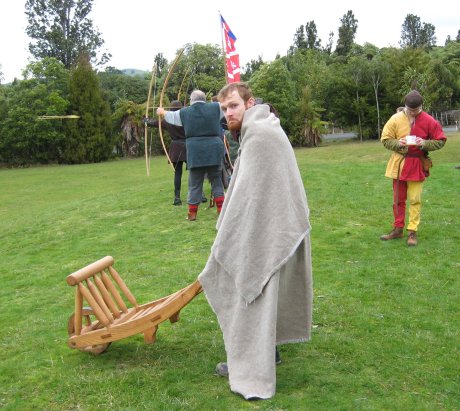
Eirik Edwardson (a Wulfing) Born 1360, son of Edward Braythwayte, an Anglo-Dane trader and craftsman and Elizabeth, his English wife. The family has homes in London & Roskilde. When in London young Eirik spends much time with the wider Wulf family and particularly Gareth. Eirik won the Silver Arrow at the 2009 St Sebastian's archery contest
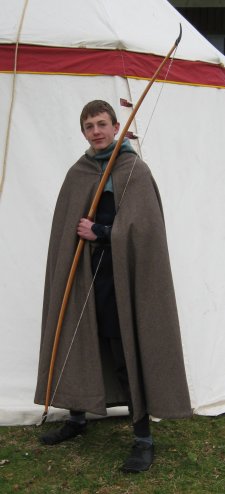
Born 1319, Newcastle, Northumberland
Died 1407, Tower of London, Middlesex
Married 1338; wife Barbel from Elberfeld in the Wupper Valley, Westphalia, in the Holy Roman Empire. They met at Deutschherrenhaus Balley, Koblenz, Trier, Holy Roman Empire whilst Mark was serving with Edward III who was in alliance with the Holy Roman Emperor Louis IV at the time. He is one of the senior armourers at the Tower of London.
Mark is descended from Njal, the youngest son of Godfrew of Garrett, who left England post Conquest to join the Varangian Guard in Constantinople. Mark’s father, Wulf Markson, was recruited from the Byzantines by Edward I’s army in Cyprus during the 9th Crusade to work as an armourer. Coming from the small ethnic English group who still formed part of the Guard and their support, his English was ‘quaint’, but understandable. He returned to England to work at the Crown’s armoury in the New Castle on the Tyne, Northumberland and married the daughter of a Welsh archer stationed there.
Sebastian Wulfson (a Wulfing)
Born 1363
Youngest son of Mark Wulfson. Named for his Saint’s day birth. Spends a lot of time with his distant relations, the Wulfs & Robertses at their holdings at Half Farthing & Wallington in the Wandle Valley, Surrey. Sebastian is a good archer & intends to become a household archer when he gets older rather than follow his father’s trade.

Airka Eóganachta Mór
(Retained Archer)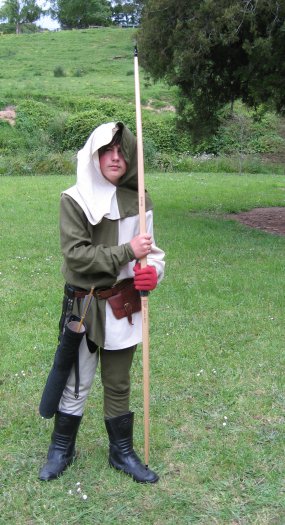
often called ‘The Irishman’ by Geffrey ðe Wulf who has problems with non-English names
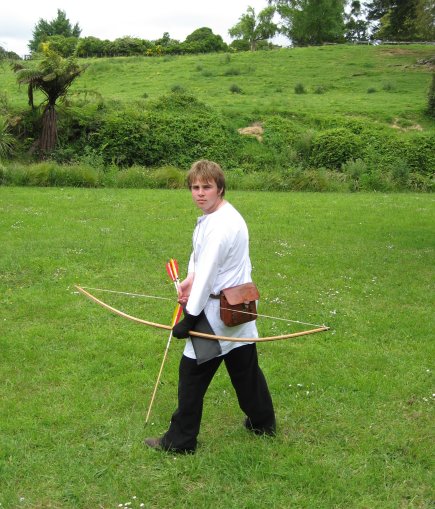
Born (1326) in the Pale of Dublin (An Pháil Shasanach), second son of an Anglo-Irish merchant and a Prussian woman whose father he met on a trading trip to Danzig. Airka was brought up speaking English,Platt Deutsch and a little Gaelic. He frequently accompanied his father to trips to English ruled Gascony where they brought wine and salt.
To seek his fortune as a younger son and have adventures, Airka travelled to England where, at Chester, he proved himself a competent archer at an Hundred Array and was able to join an English army being recruited for the war in France.
Airka served under Sir Alan de Buxhall in the army of Henry Duke of Lancaster in Normandy & Brittany. As part of an escort to Geffrey ðe Wulf, who was acting as messenger from the Duke to the Prince of Wales, Airka ended up fighting in the battle of Poitiers (or Petters as the Prince of Wales spelt it).
As his contract to serve Sir Allen expired by the time he reached Bordeaux after the Battle of Poitiers, Airka signed on to serve The Prince of Wales in Gascony.
Later as one of the Bordeaux garrison, Airka was part of the escort that accompanied Princess Joan (The Fair Maid of Kent) back to England with Richard, the son she had borne the Prince of Wales. Rather than returning to Bordeaux, Airka became one of the archers garrisoned at The Tower of London.
Currently a retained archer in the household of Sir Allen de Buxhall K.G., Constable of the Tower of London, Airka is frequently seen helping Sir Alan’s household archer Geffrey đe Wulf on special duties. Airka won the Silver Arrow at St Sebastian's 2013, 2015 & 2016 (missing out on the Golden Arrow by one point).
Hakon de Falcon (Retained Archer)

In 1340, Hakon was accepted into the Hundred array as an archer. Being of minimum age for service and unproven in battle, he was assigned to garrison duty in Bamburgh Castle. He surreptitiously exchanged places with a married archer whose wife was expecting a baby, took that man’s place aboard a ship heading to France, and subsequently fought as an archer in the naval battle of Sluys.
Hakon remained in Flanders following King Edward III’s unsuccessful campaign, he then hired himself out as a mercenary to first the Count of Flanders and then the Duke of Burgundy before rejoining the English army in the 1346 invasion. There he served in a raiding unit in French lands independent of the main army. Hakon ensured that not all of the plunder and loot that he collected went to the King.
Hakon fought in the battle of Crecy alongside Gareth of Tenby (the uncle of Gareth Robertson & Gwyn Roberts), who lost his life in the final French attack. In the battle Hakon was acknowledged as a marksman for taking out a notable number of French knights.
After the battle of Crecy he took part in the long siege of Calais, where he was wounded in the arm by a stray crossbow bolt. He was then invalided back to England where, on recovery, he became part of the Tower of London garrison.
Currently a retained archer in the household of Sir Alan de Buxhall K.G., Constable of the Tower of London, Hakon is frequently seen helping Sir Alan’s household archer Geffrey đe Wulf on special duties.
Hakon has won the Golden Arrow at the 2010, 2012 & 2014 St Sebastian's archery contest and thus became the Ildhafn Baronial Champion for those years. In 2013 he shot but was not able to retain the Golden Arrow due to an incident that happened when he was in the stocks. It appears that he was accused by a woman of either trying to take all her silver, or trying to kill her; accounts vary. Whilst in the stocks nasty youths decided to dump water on him from an iron cauldron, which they then dropped on his head. This gave him double vision and at the archery contest later his arrows went not where they should.
Finding garrison life at The Tower not up to his need for adventure, and with there now being a truce with France, Hakon has temporarily left Sir Alan's service to take up employment within the Holy Roman Empire.
Lyulf St George (Retained Archer)
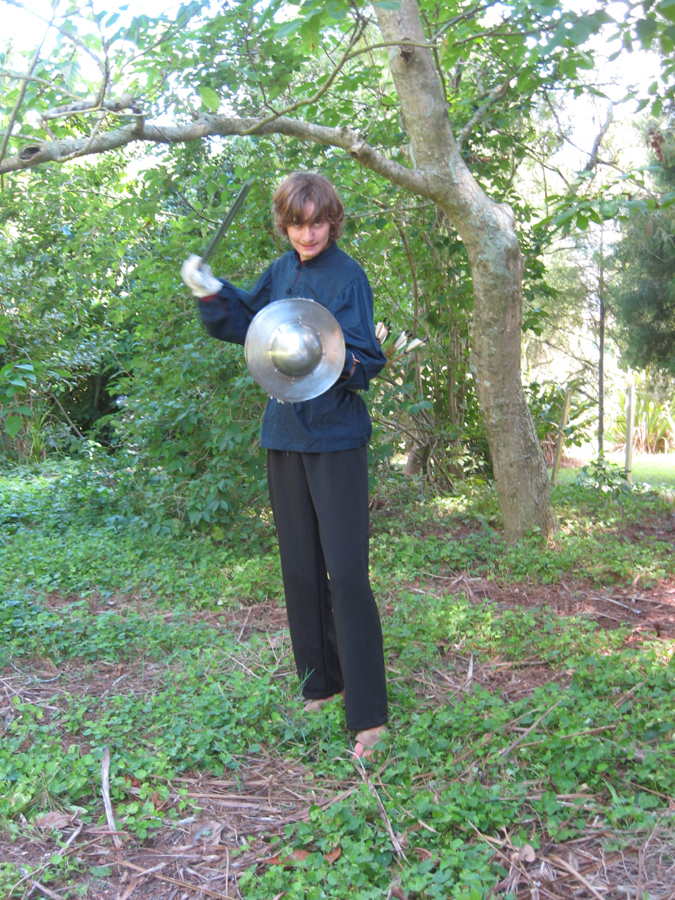
Born Northumberland, details unknown.
A former smuggler from somewhere near the Scottish border.
With his first name meaning "Lit Up Wolf", and his second name that of England’s patron saint it may symbolise the fact that he was an outlaw or wolf’s head who joined the army as an archer rather than being hunted down and hanged.
Possibly because he was an outlaw until recently, Lyulf has, until recently, served exclusively in France. After fighting & getting badly injured at Crecy he served mainly on garrison duty in various towns in Normandy. During a siege of St. Sauveur in Normandy, where he served under Sir Alan de Buxhall who was Keeper & Captain, Lyulf was injured by cannon fire. He was sent to England to convalesce and subsequently became part of the garrison at The Tower of London.
Currently a retained archer in the household of Sir Alan de Buxhall K.G., Constable of the Tower of London, Lyulf is frequently seen helping Sir Alan’s household archer Geffrey đe Wulf on special duties.
Mark the Archer of Plymouth (a Wulfing)
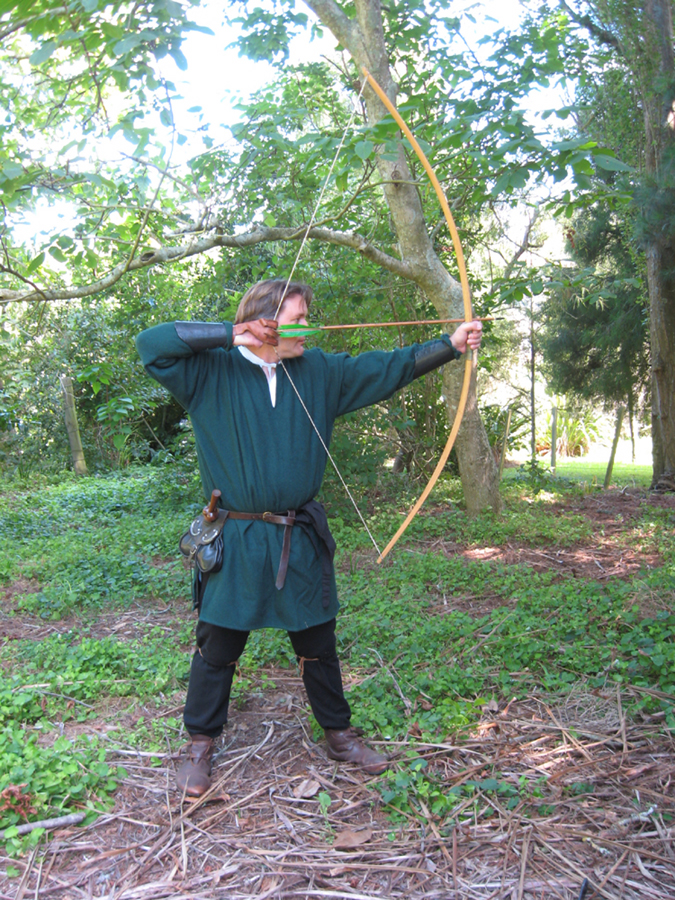

Born 1321 in Plymouth, Devonshire. Early on Mark became a professional sailor, mostly working along the southern English coastal ports and English holdings in the Channel Islands and Gascony. Seeking greater wealth he signed in Plymouth a contract of indenture with Bartholomew de Burghersh on the eve of the Prince of Wales’ 1355 chevauchée to France. Among other less illustrious actions this resulted in him taking part in the defence of de Burghersh’s forces following a French ambush outside Romorantin and the subsequent Battle of Poitiers.
Following the unsuccessful Rheims campaign and Treaty of Brétigny in 1360, Mark briefly returned to sailoring before marrying, somewhat late in life, his Jersey wife. With the family to consider Mark had another career change when he took up farming in the parish of St. Peter, Jersey.
Over forty years previously Sir John des Roches, the then Keeper of Jersey recommended that the island of Jersey’s defence should come from islanders while The King’s Castle at Gorey be maintained by an English garrison. The current Keeper of Jersey and Constable of Gorey Castle, Edmund Rose, enlisted twenty men-at-arms and twenty archers to the Jersey garrison in 1372. As an Englishman Mark was eligible to be one of those twenty archers and promptly joined up.
The following year in 1373 Bertrand de Guesclin with a sizable French army attacked Jersey and besieged Gorey Castle. With the outer ward wall breached English mainland troops arrived and relieved the castle at Michaelmas in late September. Now with family in mind, and in an opportunistic chance exchange with the relieving forces, Mark signed a new contract of indenture taking up garrison duty at The Tower of London.
He is frequently seen in the company of Geffrey Wulf.
Mark has won the Silver Arrow at the 2010 and 2012 St Sebastian's archery contest and the Golden Arrow in 2013 and was Baronial Champion for that year.
Albert Bossard (Retained Archer)
A Schwiizer who was part of the army of the Holy Roman Emperor during the Flanders Campaign. Wounded he was left behind and so took service with the English. Currently serving under Sir Alan as part of the Tower of London garrison.
Albert was the winner of the Silver Arrow at St Sebastian's 2018.
Denis Darkfire (Retained Archer - of sorts)
Real name Dinesh Avinash Nandakumar. Born 1336 in Sarandib, Ceylon.
Denis is the son of a jewel trader, specialising in sapphires. He accompanied his father to London as a youth and now acts as his father’s London agent. Attracted to the yeomen practicing archery at the Tower of London butts he took up the bow and now acts as a temporary fill in archer for the Tower garrison when Sir Alan needs men and Denis has no trade in hand.
Denis got his name from his tendency to solve all problems with bad debtors by settling fire to first outbuildings and then, if no money is forthcoming, the debtor’s house. Well respected, even feared, amongst those in the jewelry trade he has very few debtors as his clients now find it safer to pay cash.
Christiana Fortrose (a Wulfing)
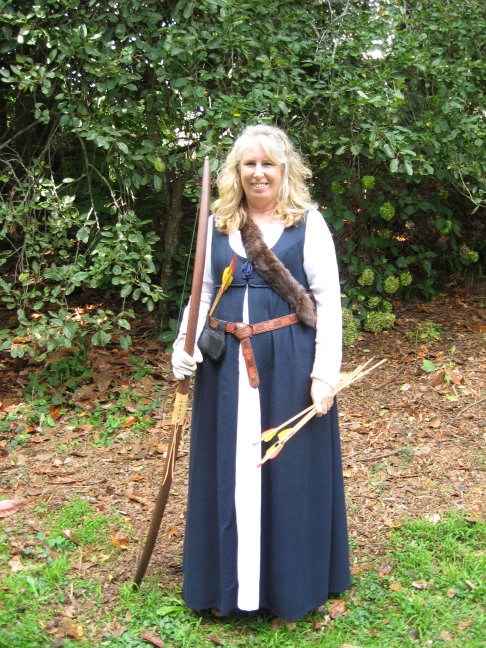
Christiana was born in 1320 at Kirkbridge, Cumberland, her mother being English and her father a Welsh drover who got stranded in the village when he broke a leg and then fell in love with his healer. When Christiana was six years old, Scottish moss-troopers from the Johnstone clan came reeving, killing her parents but taking her as booty. She was traded as a slave to the Sutherlands, and the Duke’s cousin, Jack Donald Sutherland, was taken by her blonde looks and not only bought her but brought her up as a fosterling.
Whilst visiting allies in the borderlands, Jack Sutherland took his foster-daughter hunting, but they found themselves ambushed by foragers from the army of King Edward III, who was besieging Berwick-upon-Tweed at the time. Jack and his bodyguard were slain, but the seventeen-year-old Christiana was taken prisoner because the soldiers heard her English accent. At the siege camp she was given into the care of David the Stringer and his wife Mathild the Laundress. Just before the Battle of Halidon Hill, Mathild died of camp fever. After winning the battle, most of the English army returned home and David took Christiana with him back to The Tower of London where he pursued his trade. In time, the couple married and produced two daughters, both of whom married men from the garrison.
Disliking her trade as a laundress, Christiana took up an apprenticeship as a fletcher.
Whilst resuming her Englishness, Christiana still has some Scottish traits both in her speech and in her diet – sliced cold porridge, well salted, is often the midday meal she shares with her husband.
A Lollard, like the Wulf family, she is often in their company, whether at archery, for she loves to hunt, or playing the English flageolet while they sing.
David the Stringer (a Wulfing)

Born in 1312 at Carlisle, Cumberland, David is a third generation bowstring-maker. Whilst his family continued to reside at Carlisle, supplying both the garrison and the local population with bowstrings and ropes, David joined first the Percy Household, and then the Royal Armoury at The Tower of London. When younger he spent much of his time as part of the King’s war train, travelling both in Scotland during Edward III’s campaign supporting Edward Balliol’s claim to the Scottish crown and in Edward’s early campaigns in Flanders and France. David was present at the siege of Calais, where he caught fen ague and was sent back to England. In recent years, mainly because of his health, he has been based at The Tower.
David’s first wife died on campaign in Scotland from camp fever. His second wife, Christiana, was originally an apprentice laundress under his wife’s care. He has two daughters from his first wife and two from his second. The elder two are with their husbands who are garrisoned in Gascony.
Edward Braythwayte (a Wulfing)

Born 1329, Master Edward is a master craftsman in metal, wood and leather. In addition to owning and running workshops, Edward is an import/export trader and is a Guildsman of the Worshipful Company of Mercers of London.
Born in Whitby, North Yorkshire, Edward is an Anglo-Dane with an English father & a Danish mother. As a child Edward spent a great deal of time at sea fishing for cod with his father, Edmund Braythwayte. Edward soon learnt that there was profit to be made through selling items that he had bartered for from the ships in Whitby harbour in the great city of York.
Edward began to trade further afield, making frequent trips to London where he established a house and workshop in Cheap Street. Braythwayte deals in many goods, both manufactured and primary. His ship, Red Fox, regularly plies not only between England & Denmark but also along the Channel and into the Baltic. Although the nature of Edward’s business means he spends much time in both London & Roskilde he tends to be on Red Fox only to travel between his English and Danish bases leaving trading trips in the hands of his Ship’s Master, Krautesh Vakir. His wife and son spend most of their time living in London.
Edward is an accomplished archer, but uses this skill for pleasure & hunting rather than war. Edward won the Golden Arrow at St Sebastian's 2015 and was Baronial Champion for that year.
Krautesh Vakir (a Wulfing)
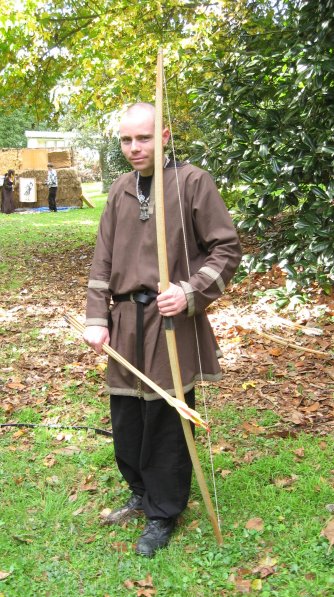
Born and bred in Roskilde, Krautesh is the ship’s master of Red Fox, Edward Braythwayte’s trading vessel. In addition to being ship’s master, Krautesh acts as Braythwayte’s factor in trading when Red Fox ties up in Normandy and the Baltic ports.
Krautesh finds being a competent archer, swordsman and axeman very useful, especially in those seas where piracy is a popular occupation rather than an amusing hobby.
In July 1361, Krautesh was in Visby, Gotland, when the Danish King, Valdemar Atterdag, invaded the Island of Gotland with his army of Danes and German mercenaries. Edward Braythwayte’s Ship's Master managed to leave the port just before the Gutnish yeomanry were trapped in front of the city walls and massacred. Being Danish, Krautesh had feared the citizens of Visby would see him as a spy, but in fleeing he knew he risked being taken by the Danish King’s fleet, who would have seen him as a Gotlander. Fortunately, his skill, as both a dissembler and a Ship's Master, saw him away and free with a cargo of Russian trade goods for Edward’s Roskilde trading centre.
When in London, Krautesh is frequently seen in the company of Sir Alan’s men, both at the butts and in the taverns. When short of men for ‘special duties’, Sir Alan has been known to provide casual employment for ship’s master Vakir if he is in port.
William (Will) Orlando (a Wulfing)

Born in 1363, Will is the Son of James Orlando a Morisco Doctor. Will was born in Logrono, Castile, near the border with the Kingdom Navarre. In 1376 Edward, Prince of Wales, brought an Anglo-Gascon army into Castile in order to help Pedro the Cruel, King of Castile, reclaim his kingdom from his illegitimate brother, Enrique of Trastamara, who had usurped the throne with the aid of an army of French mercenaries under the command of Bertrand du Guesclin. The combined armies of Edward and Pedro were 24,000 strong and met the French-Castilian army of 60,000 at Najera, near Logrono. The English archers devastated their foes before the Anglo-Gascon cavalry took the enemy in the rear. In the aftermath Dr James, helped by his son, attended the wounded. As Pedro refused to pay for James’ service he thereby became attached to the English army on a permanent basis.
James travelled to England via Bordeaux in order to provide care for Prince Edward’s new born son, Richard of Bordeaux (later King Richard II). Will also made the journey keeping company with the archers and soon became one himself. Currently he is based at the Tower of London, where Dr James is also based.
Clifford of Cumberland (born 1308) a Wulfing Clifford being born in Lancashire 1308, served as an archer with the Earl of Chester. His experiences in border skirmishes against the North Welsh and his valour were noted and he was given a place in the bodyguard of the Earl. He fought with Edwards army against the Scots who were defeated at the Battle of Halidon Hill. After this time, he was given a position of Verderer (Forester Huntsman) with Edward The Black Prince Earl of Chester, He fought with distinction at the Battle of Crecy being part of the Prince of Wales Bodyguard. He was sent home because of wounds received in battle. It wasn’t long before he was in the battle lines again when the Scots under King David 11 Crossed the border and tried to take Durham. At the battle of Neville’s Cross, the outnumbered English army led by Archbishop Of York, William de la Zouche ,defeated the Scots and captured the Scots King and many of his nobles. Because of his leadership he was given part of the ransom of the Earl of Sutherland and retirement as a chief huntsman for Edward Earl of Chester.
On his retirement Clifford and his wife moved to London to be near to his daughter whose husband was from that city. Once in London Clifford sought out the Archers of the Tower of London so he could continue to draw and loose his shafts. He is often seen at the Tower training young archers and passing on his love for the Longbow. He can also be found in a local Tavern “The Archers Revenge” where he regales the youngers archers with tales of French knights rolling in the mud and much butchery and slaughter When he has had sufficient cider, he sings rowdy lewd songs and ballads about archers, girls and the bloody way of war, till someone takes him home. “Thank the Lord” and bless his wife These words are sworn true, on oath before Prior of St Christ fore, East Peckham
Mistress Katherine Xavier (a Wulfing)
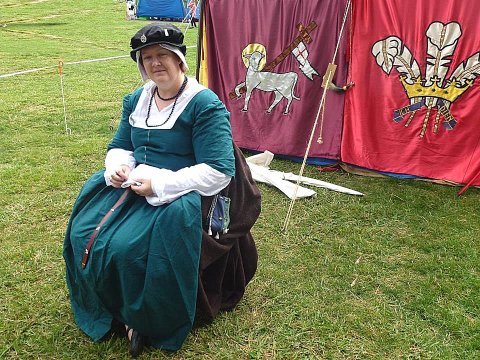

Mistress X was born in 1343 at Nolay in Burgundy and her native language is the French dialect of that region. She is, however, fluent in English of the London variety. On the death of her husband, Phillip Xavier, a wine merchant, the Vintners Company of London allowed her to carry on in his trade as long as she based herself in Upper Thames Street, where other members of the Company could assist her if need be.
Occasionally Mistress X, as she is know, does get into some grief, particularly when it comes to paying the Customs due on her imports. Fortunately she has an “arrangement” with the Constable of the Tower of London, Sir Allayne de Buxhall, regarding the supply of fine wines to The Tower . When problems arise Sir Allayne, or his Household Archer Geffrey Wulf, act as mediators with the Comptroller of Customs in London, Geffrey Chaucer.
In order to bring in wine, both from Burgundy and Gascony, Mistress X uses the services of Edward Braythwate and his ship' “The Red Fox”. In order to trade for the wine Mistress X exports pickled herrings, clothes and honey. An experienced seamstress, Mistress X makes clothes to order for Sir Allayne's garrisons both at the Tower and his holdings in France.
Julia Newland (a Wulfing)

Born Juliana Fillebein at Saint-Sauveur-le-Vicomte, Normandy, France in 1328, she is the daughter of Jean Maîtrefer, blacksmith to the castle garrison. During the time Sir Alan de Buxhall was Captain and Commander of the town for Sir John Chandos, Juliana served as part of the domestic staff for the castle. Sir Alan was so impressed with her work, integrity, and discretion he offered her the role of housekeeper to his quarters at the Tower of London, where he now held the honour of Constable. Skilled at playing the fiddle, Julia often provides entertainment to Sir Alan’s guests, including the Duke of Lancaster and Geffrey Chaucer.
Juliana was already fluent in English due to the time she had been working with the English garrison of her home town and, on coming to England, she took the name Julia Newland, to make it easier for the English, who had problems pronouncing her proper name, and to acknowledge that she had come to a new land and started a new life.
Recently Julia has been seen to be spending a lot of time on the company of Airka Eóganachta Mór, which concerns her employer as he is not keen on losing a favoured member of his personal staff to one of his Retained Archers. Since meeting Airka she has taken to practicing archery!
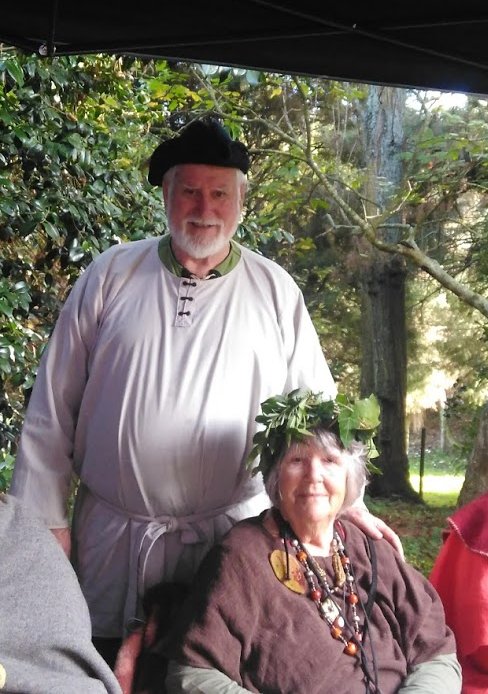
Alexander Wulfgar the Waggoner (a Wulfing)
Born in 1310, Wulfgar, as he is best known, is from the village of Bingham near Nottingham. The second eldest of nine, Wulfgar worked for the local squire, farmer John Brown. Here he learnt the skill of handling teams of horses both in field and on the road to market, travelling widely throughout the Midlands of England. In his spare time he was with the local blacksmith, who was an amazing artificer of metals in general. Being of yeoman stock, Wulfgar had to comply with the Law and practice archery every Sunday at the village butts.
Fighting as an archer on the losing English side in 1327 at the Battle of Stanhope Park, when the Scots raided King Edward III’s camp and nearly captured the King, Wulfgar was struck on the leg, leaving him unsuitable for continuing as a fighting man. The result was that he became a waggoner full-time, though still capable of putting up arrows when needed, and in this role he continued to serve the King in England, Flanders, and France.
In recent years Wulfgar’s age has caught up with him, and now he is based at The Tower of London and only does local runs with his waggon and team of horses. In addition to being a waggoner, Wulfgar still does some blacksmithing. Now that he is at The Tower, Wulfgar is often in the company of Geffrey ðe Wulf and his companions, and regularly practices his old skill of archery at The Tower butts.
Megg of Foxbury (a Wulfing)
Born in 1318 at the Manor of Foxbury in Kent, Megg is the youngest daughter of the Squire of Foxbury. In 1343, Megg went to serve Sir Alan de Buxhall’s first wife as a maid in waiting following his marriage. Her departure from Foxbury was under a cloud, the reason for it never being explained. Again, for unexplained reasons, Megg left Sir Alan’s Manor of Buzsell and joined Sir Alan’s Military Household on campaign to France in 1355 where she, being a skilled herbalist, served in the camp, specialising in care for the wounded and ill.
Unlucky in marriage, having lost two husbands in the various French and Flemish campaigns, Megg became friends with Alexander Wulfgar, and joined him on his later trips during King Edward III’s French campaigns. Their last joint trip was in July 1380, when the Earl of Buckingham conducted an expedition to France to aid England's ally, the Duke of Brittany. It was during this chevauchée that Wulfgar started to have health problems, and he and Megg returned to England whilst the Earl conducted his siege of Nantes.
Once again in the service of Sir Alan, Megg conducts many diverse duties: at times she is seen acting as a lady in waiting to Sir Alan’s second wife, Maud Fraunceys; conversely she can be seen herding goats on Sir Alan’s holding at Harold’s Hill in Essex, helping with the horses at The Tower’s stables, or stick-weaving cloth whilst sitting in the sun on Tower Green watching all the many things that go on there.
Peter att Rickmansworth (Chaplin to the Household)

Born in Peckham, Kent, in 1323, Peter became a friend of the village priest, a distant family member, and through him received a basic education, which included sufficient Latin to be able to help with the religious services. In time Peter took Minor and then Major orders finally replacing the priest at Rickmansworth, who was another distant relative.
Peter, being a yeoman’s son, was an experienced archer. Without his Bishop’s permission he discarded his clerical robes and became an arrayed archer and joined other archers bound for France from the manor when they did service for the Lord of the Manor, the Abbot of St Albans. The archers served under the Knight Bannerette Roger de Bacheworth, lord of the manor of nearby Harefield. Peter did not disclose that he was a priest and his Rickmansworth parishioners kept his secret. Peter was present during the siege of Calais. During a fight with a French ship that was trying to get supplies into the town, Peter was hit by a cross bow bolt in the shoulder. He received care and healing from one of Roger de Bacheworth’s maid servants. Love blossomed and they secretly married. Peter was invalided home before the town fell to King Edward III’s forces and, following the crossing of palms with silver, his wife accompanied him and the other wounded soldiers.
Peter’s problems began when the Archbishop of Canterbury became aware of Peter’s domestic arrangements and the fact that he had neglected the parish to go to war as an archer. Following a visitation by a representative of the Abbot of St Albans, who had become concerned that the folk of Rickmansworth had somehow, for a long period, lost their priest, and everyone there denied knowing where he had been for the past ten months, the Archbishop demanded a full investigation of the matter and that, in the meantime, Peter be detained at St Albans Abbey.
Fortunately for Peter before this could happen he had contacted John Wycliffe, who had tutored him at one time. John, using his influence with His Grace John of Gaunt, Duke of Lancaster, found Peter a position as Chaplin to Sir Alan de Buxhall KG, Constable of the Tower of London. The Tower is a Liberty, extra-parochial and a Royal Perculiar and thus outside the jurisdiction of the bishop and archdeacon of the diocese in which it is situated and outside the control of the local civil authorities too. Sir Alan, although not a Lollard himself, is sympathetic towards them; indeed some of his Household are notorious Lollards. Sir Alan has kindly found a position for Peter’s common law wife within his Tower Household, thus keeping the family together.

Peter at The Tower of London receiving his Licence to be Sir Alan's Chaplin from Geffrey ðe Wulf
Etain ingen Choilein (a Wulfing)

Born and raised in County Cork Ireland, Etain is the daughter of a local clan chief.
Etain grew up helping with the family business of breading and trading horses. At the age of fourteen she married a cousin at her father’s insistence. In an effort to expand the family business her husband travelled to England taking Etain, and their young son with him.
Regrettably, in Chester, Etain’s husband was found floating face down in a local cess pit after another night of drunken debauchery.Left alone to fend for herself, Etain took over his trade of buying and selling of horses. So successful was she that she soon made enough money to settle the debts her late husband had left, and, moving to London, soon proved herself a canny and honest trader. In time she gained the contract to supply horses for The Tower of London garrison.
A keen archer Etain soon fell in with Sir Alan de Buxhall’s Household based at The Tower and now enjoys spending as much time at the butts with them as she can.
Gerard Muckaway (a Wulfing)
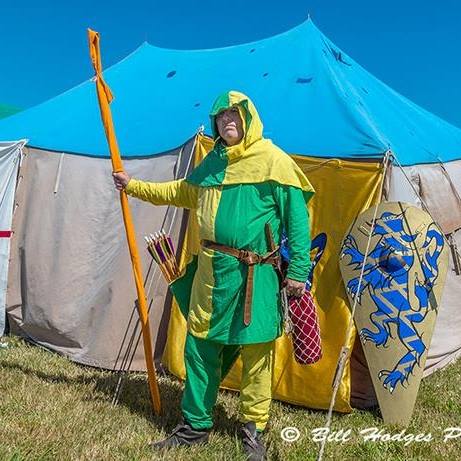
Born in 1312 at Gravesend, Kent, Gerard followed in the family trade as a gong farmer for the town, emptying the cess pits and piss buckets and then weathering the materials until they could be sold on as manure, ammonia or as curing fluids for tanning.
Proving to be a shrewd businessman, Gerard has made enough money to employ staff and is now of yeoman worth.
Since he picked up the contract to clear the pits and pots of The Tower of London, Gerard practices archery, as required by law, in the company of The Tower garrison and Sir Alan’s Household.
Now that much of the actual muck clearing is being done by his minions Gerard has taken to wearing clothes that are more fitting to his station and has a taste for bright colours.
Like many associated with The Tower, Gerard is a Lollard and is part of the underground network distributing English translations of the Bible. In this Gerard is a key link into Kent for the works of John Wycliffe and his helpers.
Gifu the Goat
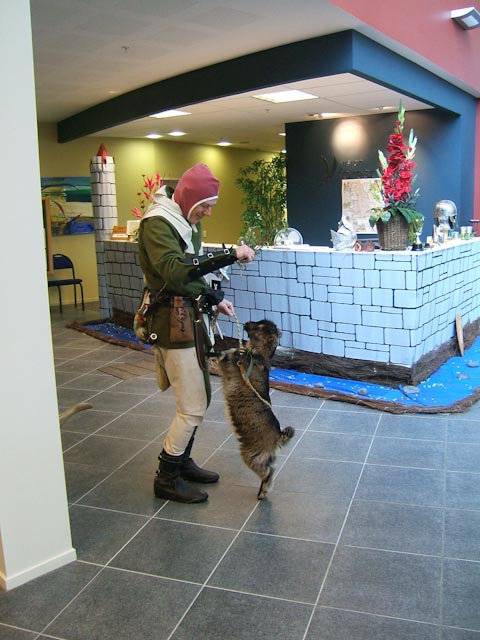
The Wulfings pet Goat, Gifu, at Vision Village Forest Lake, Hamilton
The Wulfings are well known for singing English folk songs.
The Wulfings after performing songs at a feast put on by St Peters Cathedral, Hamilton
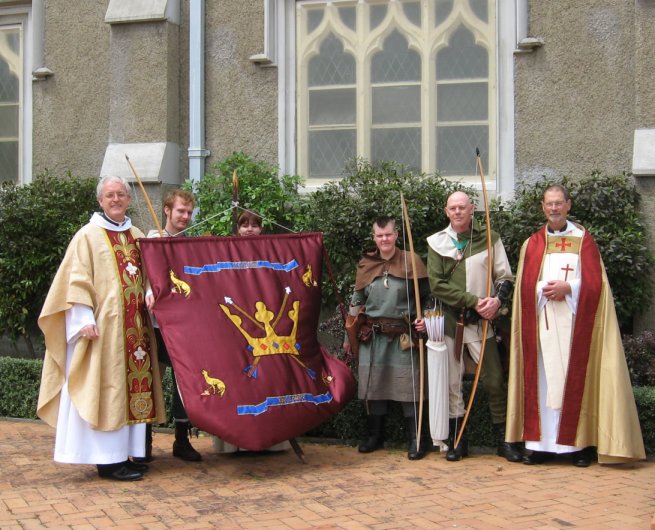
The blessing of our banner of St Eadmund King & Martyr:
Patron saint of English archers & wolves.
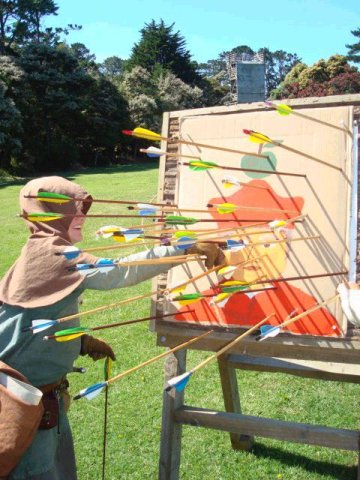
Lollard archers prefer to shoot Cardinals to apples!

The winners of Best Club - Te Awamutu Christmas Parade 2008
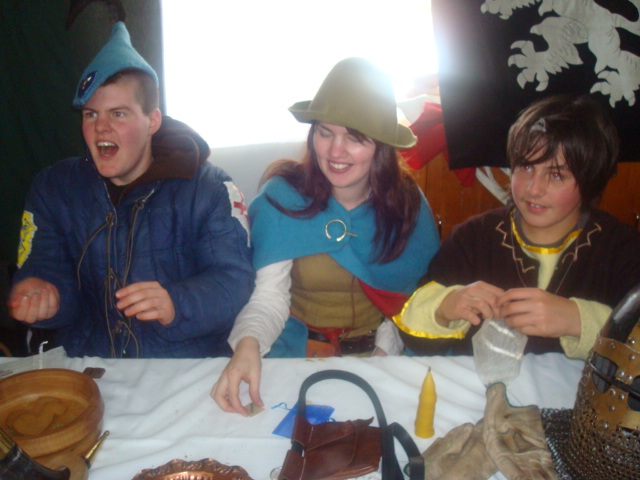
The Wulf Pack: bookies and money lenders to the nobility. As you can see from their smiles - the book usually wins!

Sword & buckler fighting at Vision Village Forest Lake, Hamilton
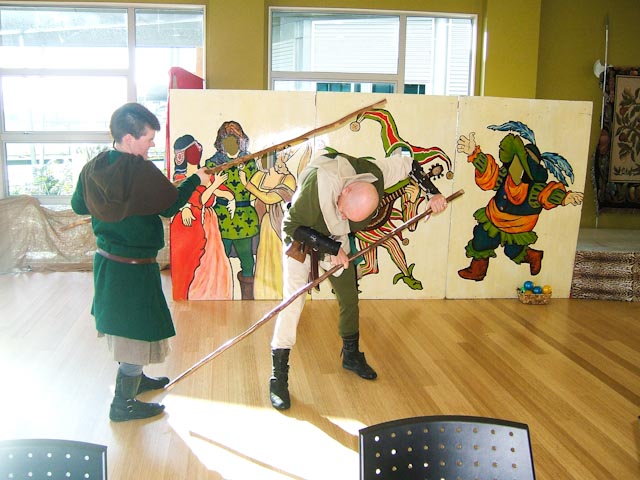
Staff fighting at Vision Village Forest Lake, Hamilton
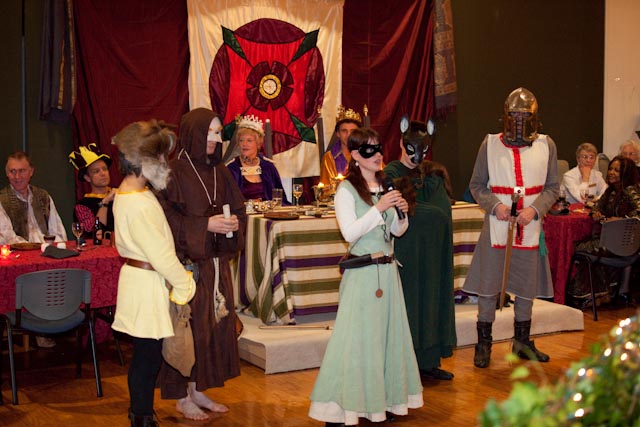
St George Mummers play at Vision Village Forest Lake, Hamilton
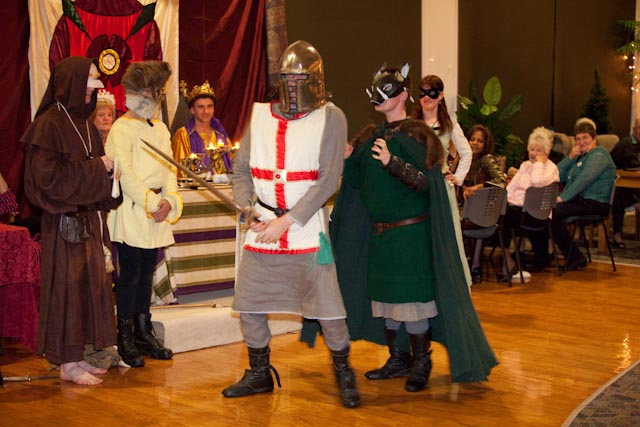
"Where's the Dragon?" - "He's behind you!"

The Wulfings sing "St George" at Vision Village Forest Lake, Hamilton
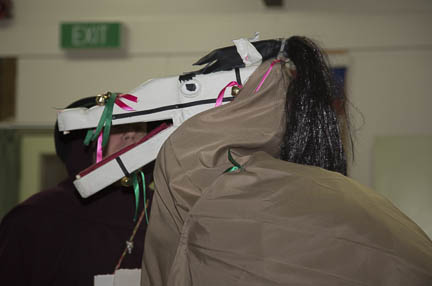
The Wulfing's Hodden Horse, Hengest
But the toast was not good enough!

Mummers at Te Awamutu Christmas Parade 2014
Swart Piet, Betsy Bright, Hengest, Maid Marion, Robin Hood, The Squire, Banner Boar, Death, St George
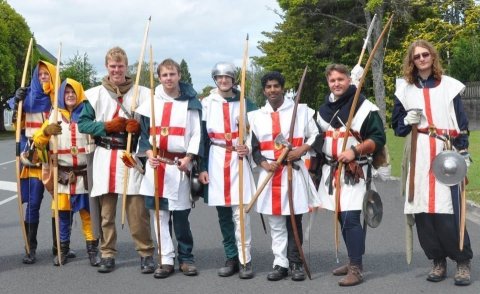
Sir Alan's men Hamilton Christmas Parade 2011
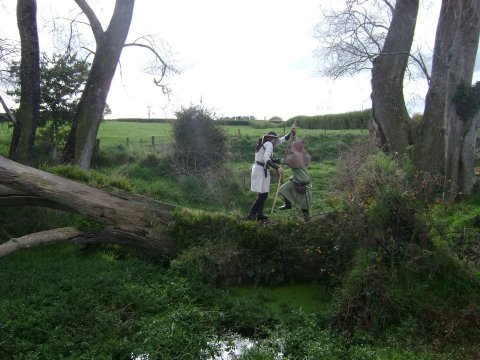
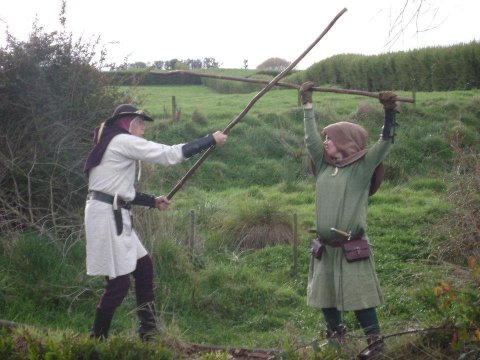

"Robin had a fight on a log
With man called Little Jog
Who made Robin look a proper twit.
He upped with his pole
And scored a perfect goal
And knocked Robin into the ----water".
(Fred Wedlock - "Robin Hood")

Albert and Hakon practicing sword and buckler

Gareth and Airka at play
Short stories about various events in the lives of the Wulf family:
The Old Patched Shirt (Petters?Peyters?Poitiers?)
Hakon's Heaving Heroics (Battle of Sluys)
Involuntary Insensate Inquest (Ghastly Grating Goat)
Return to
Geffrey đe Wulf